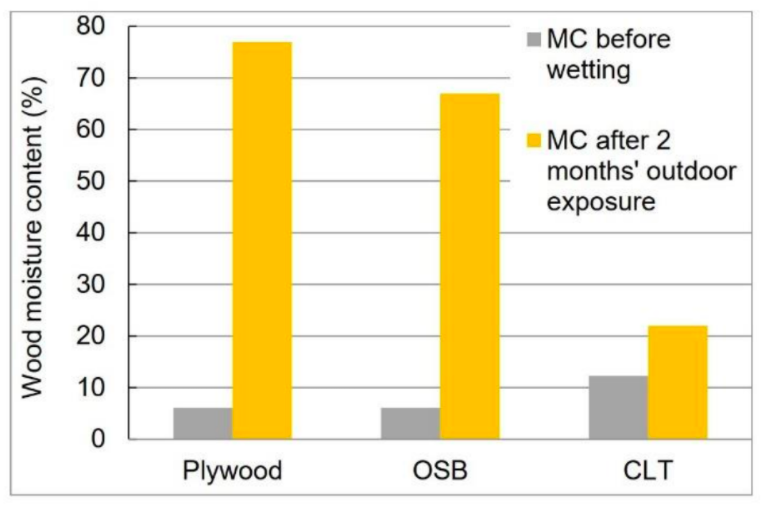SHIRIN GOLKARIEH, MBSc
Towards analyzing the impact of weathering on the performance of mass timber - considering moisture cycling, solar radiation, and temperature cycling
Read the full Master Research Paper HERE.
Cross-laminated timber (CLT) is an engineered wood product consisting of three or more alternating layers of dimension lumber glued together with high dimensional stability. There are chances of several environmental impacts such as exposure to multiple periods of rain, high humidity levels, sun radiation, and mould which will age the CLT panels and damage the product over a long period of time. Accelerated aging treatments are laboratory-based methods which simulate the natural degradation mechanism under a controlled condition at a higher speed to evaluate the durability performance of wood panel products. As CLT panels are a relatively new engineered wood product, the effects of aging treatments on its properties have yet to be properly analyzed. The experimental phase of this research includes making CLT panels by following the CLT-handbook instructions in the laboratory and conducting accelerated weathering tests on them. In this research four different types of CLT samples were exposed to two different weathering treatments, namely, “hygrothermal treatment” and “UV light & water spray”. The results were used to conduct comparisons between 5-ply versus 3-ply and edge glued versus none-edge-glued. The reported density and moisture content changes provide an overview of the physical modifications of the samples. The microscopic pictures that were taken before and after the treatments from the exact same surface edges show the impacts of the moisture and temperature cycling on the surface edges. 5-ply samples experienced higher deterioration than 3-plys at the end of the aging process; edge-glued samples also experienced the most significant cracking. The results of both tests showed that the end grains and the gaps between laminations present the largest risks of wetting in a CLT assembly. The results would be important for future mass timber buildings dealing with active or constant moisture sources and UV light.
Towards analyzing the impact of weathering on the performance of mass timber - considering moisture cycling, solar radiation, and temperature cycling
Read the full Master Research Paper HERE.
Cross-laminated timber (CLT) is an engineered wood product consisting of three or more alternating layers of dimension lumber glued together with high dimensional stability. There are chances of several environmental impacts such as exposure to multiple periods of rain, high humidity levels, sun radiation, and mould which will age the CLT panels and damage the product over a long period of time. Accelerated aging treatments are laboratory-based methods which simulate the natural degradation mechanism under a controlled condition at a higher speed to evaluate the durability performance of wood panel products. As CLT panels are a relatively new engineered wood product, the effects of aging treatments on its properties have yet to be properly analyzed. The experimental phase of this research includes making CLT panels by following the CLT-handbook instructions in the laboratory and conducting accelerated weathering tests on them. In this research four different types of CLT samples were exposed to two different weathering treatments, namely, “hygrothermal treatment” and “UV light & water spray”. The results were used to conduct comparisons between 5-ply versus 3-ply and edge glued versus none-edge-glued. The reported density and moisture content changes provide an overview of the physical modifications of the samples. The microscopic pictures that were taken before and after the treatments from the exact same surface edges show the impacts of the moisture and temperature cycling on the surface edges. 5-ply samples experienced higher deterioration than 3-plys at the end of the aging process; edge-glued samples also experienced the most significant cracking. The results of both tests showed that the end grains and the gaps between laminations present the largest risks of wetting in a CLT assembly. The results would be important for future mass timber buildings dealing with active or constant moisture sources and UV light.
